Advertisements
Advertisements
Question
The emf of a standard cell is 1.5V and is balanced by a length of 300 cm of a potentiometer with a 10 m long wire. Find the percentage error in a voltmeter that balances at 350 cm when its reading is 1.8 V.
Solution
Given:
E1 = 1.5 V, l1 = 300 cm, l2 = 350 cm
From individual cell method of potentiometer,
`"E"_1/"E"_2 = "l"_1/"l"_2`
∴ E2 = E1 × `"l"_2/"l"_1`
= `1.5 xx 350/300 = 1.75`V
But given reading is 1.8 V
∴ Error = 1.8 – 1.75 = 0.05 V
∴ Percentage error = `0.05/1.75 xx 100`
= 2.8571%
The percentage error in a voltmeter is 2.8571%.
APPEARS IN
RELATED QUESTIONS
State the principle of working of a potentiometer.
Figure shows a potentiometer with a cell of 2.0 V and internal resistance 0.40 Ω maintaining a potential drop across the resistor wire AB. A standard cell which maintains a constant emf of 1.02 V (for very moderate currents up to a few mA) gives a balance point at 67.3 cm length of the wire. To ensure very low currents drawn from the standard cell, very high resistance of 600 kΩ is put in series with it, which is shorted close to the balance point. The standard cell is then replaced by a cell of unknown emf ε and the balance point found similarly, turns out to be at 82.3 cm length of the wire.
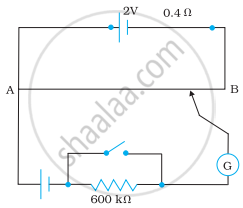
(a) What is the value ε?
(b) What purpose does the high resistance of 600 kΩ have?
(c) Is the balance point affected by this high resistance?
(d) Is the balance point affected by the internal resistance of the driver cell?
(e) Would the method work in the above situation if the driver cell of the potentiometer had an emf of 1.0 V instead of 2.0 V?
(f) Would the circuit work well for determining an extremely small emf, say of the order of a few mV (such as the typical emf of a thermo-couple)? If not, how will you modify the circuit?
Figure shows a 2.0 V potentiometer used for the determination of internal resistance of a 1.5 V cell. The balance point of the cell in open circuit is 76.3 cm. When a resistor of 9.5 Ω is used in the external circuit of the cell, the balance point shifts to 64.8 cm length of the potentiometer wire. Determine the internal resistance of the cell.
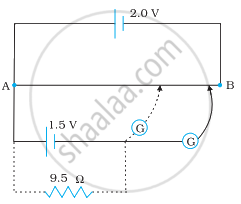
In the given circuit, with steady current, calculate the potential drop across the capacitor and the charge stored in it.

Write the principle of working of a potentiometer. Describe briefly, with the help of a circuit diagram, how a potentiometer is used to determine the internal resistance of a given cell.
When a resistor of 5Ω is connected across the cell, its terminal potential difference is balanced by 150 cm of potentiometer wire and when a resistance of 10 Ω is connected across the cell, the terminal potential difference is balanced by 175 cm same potentiometer wire. Find the balancing length when the cell is in open circuit and the internal resistance of the cell.
Would you prefer a voltmeter or a potentiometer to measure the emf of a battery?
The net resistance of an ammeter should be small to ensure that _______________ .
The potentiometer wire AB shown in the figure is 40 cm long. Where should the free end of the galvanometer be connected on AB, so that the galvanometer may show zero deflection?

The potentiometer wire AB shown in the figure is 50 cm long. When AD = 30 cm, no deflection occurs in the galvanometer. Find R.
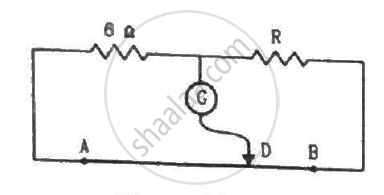
In a potentiometer experiment, the balancing length with a resistance of 2Ω is found to be 100 cm, while that of an unknown resistance is 500 cm. Calculate the value of the unknown resistance.
Draw a labelled circuit diagram of a potentiometer to compare emfs of two cells. Write the working formula (Derivation not required).
When the balance point is obtained in the potentiometer, a current is drawn from ______.
Define potential gradient of the potentiometer wire.
How is potential gradient measured? Explain.
What are the disadvantages of a potentiometer?
A potential drop per unit length along a wire is 5 × 10−3 V/m. If the emf of a cell balances against length 216 cm of this potentiometer wire, find the emf of the cell.
What will be the effect on the position of zero deflection if only the current flowing through the potentiometer wire is decreased?
Why is a potentiometer preferred over a voltmeter for measuring emf?
When two cells of emf's E1 and E2 are connected in series so as to assist each other, their balancing length on a potentiometer wire is found to be 2.7 m. When the cells are connected in series so as to oppose each other, the balancing length is found to be 0.3 m. Compare the emf's of the two cells.
The emf of a cell is balanced by a length of 120 cm of a potentiometer wire. When the cell is shunted by a resistance of 10 Ω, the balancing length is reduced by 20 cm. Find the internal resistance of the cell.
The SI unit of the potential gradient is ______
When the null point is obtained in the potentiometer, the current is drawn from the ______
If the potential gradient of a wire decreases, then its length ______
State any one use of a potentiometer.
A cell of e.m.f 1.5V and negligible internal resistance is connected in series with a potential meter of length 10 m and the total resistance of 20 Ω. What resistance should be introduced in the resistance box such that the potential drop across the potentiometer is one microvolt per cm of the wire?
A 10 m long wire of resistance 20 Q is connected in series with a battery of emf 3 V and a resistance of 10 Ω. The potential gradient along the wire in V/m is ________.
The resistivity of potentiometer wire is 40 × 10-8 ohm - metre and its area of cross-section is 8 × 10-6 m2. If 0.2 ampere current is flowing through the wire, the potential gradient of the wire is ______.
Select the WRONG statement:
The length of a potentiometer wire is L. A cell of e.m.f E is balanced at length L/3 from the positive end of the wire. If the length of wire increases by L/2, then the same cell will give balance point at length ____________.
To determine the internal resistance of a cell by using potentiometer, the null point is at 1 m when cell is shunted by 3 Ω resistance and at a length 1.5 m when cell is shunted by 6 Ω resistance. The internal resistance of the cell is ______.
A cell of e.m.f. 'E' is connected across a resistance 'R'. The potential difference across the terminals of the cell is 90% ofE. The internal resistance of the cell is ______.
A potentiometer wire of length 100 cm has a resistance of 10 `Omega.` It is connected in series with a resistance and an accumulator of e.m.f 2 V and of negligible internal resistance. A source of e.m.f 10 mV is balanced against a 40 cm length of the potentiometer wire. The value of the external resistance is ____________.
The length of a wire of a potentiometer is 100 cm, and the e.m.f of its standard cell is E volt. It is employed to measure the e.m.f of a battery whose internal resistance is 0.5 `Omega` If the balance point is obtained at `l`= 30 cm from the positive end, the e.m.f of the battery is ____________.
where 'i' is the current in the potentiometer
When two cells of e.m.f 1.5 V and 1.1 V connected in series are balanced on a potentiometer, the balancing length is 260 cm. The balancing length, when they are connected in opposition is (in cm) ____________.
The current drawn from the battery in the given network is ______
(Internal resistance of the battery is neglected)

If the length of potentiometer wire is increased, then the length of the previously obtained balance point will ______.
In a potentiometer experiment when three cells A, B, C are connected in series the balancing length is found to be 740 cm. If A and B are connected in series, the balancing length is 440 cm and when B and C are connected in series, it is 540 cm. The e.m.f. of A, B, and C cells EA, EB, EC are respectively (in volt) ______
In the potentiometer experiment, the balancing length with a cell E1 of unknown e.m.f. is 'ℓ1' cm. By shunting the cell with resistance R Ω, the balancing length becomes `ℓ_1/2` cm, the internal resistance (r) of a cell is ______
In the potentiometer experiment, cells of e.m.f. E1 and E2 are connected in series (E1 > E2). the balancing length is 64 cm of the wire. If the polarity of E2 is reversed, the balancing length becomes 32 cm. The ratio `E_1/E_2` is ______
In a potentiometer experiment, for measuring internal resistance of a cell, the balance point has been obtained on the fourth wire. The balance point can be shifted to fifth wire by ______.
It is observed in a potentiometer experiment that no current passes through the galvanometer when the terminals of the cell are connected across a certain length of the potentiometer wire. On shunting the cell by a 2 Ω resistance, the balancing length is reduced to half. The internal resistance of the cell is ______.
The sensitivity of the potentiometer can be increased by ______.
A 10 m long wire of uniform cross-section and 20 Ω resistance is used in a potentiometer. The wire is connected in series with a battery of 5 V along with an external resistance of 480 Ω. If an unknown emf E is balanced at 6.0 m length of the wire, then the value of unknown emf is ______.
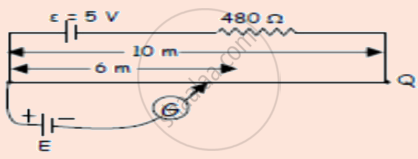
AB is a wire of potentiometer with the increase in value of resistance R, the shift in the balance point J will be:

A wire of resistance R is cut into two equal part. There parts are then connected in parallel. The equivalent resistance of the combination will be
AB is a potentiometer wire (Figure). If the value of R is increased, in which direction will the balance point J shift?
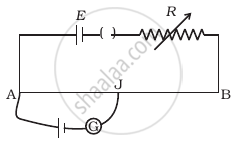
For the circuit shown, with R1 = 1.0 Ω, R2 = 2.0 Ω, E1 = 2 V, and E2 = E3 = 4 V, the potential difference between the points 'a' and 'b' is approximately (in V) ______.
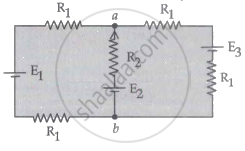
A Daniel cell is balanced on 125 cm lengths of a potentiometer wire. Now the cell is short circuited by a resistance 2 Ω and the balance is obtained at 100 cm. The internal resistance of the Daniel cell is ______.
As a cell age, its internal resistance increases. A voltmeter of resistance 270 Ω connected across an old dry cell reads 1.44 V. However, a potentiometer at the balance point gives a voltage measurement of the cell as 1.5 V. Internal resistance of the cell is ______ Ω.
A cell of internal resistance r is connected across an external resistance nr. Then the ratio of the terminal voltage to the emf of the cell is ______.
A potentiometer wire AB having length L and resistance 12r is joined to a cell D of emf ε and internal resistance r. A cell C having emt `ε/2` and internal resistance 3r is connected. The length AJ at which the galvanometer as shown in the figure shows no deflection is ______.
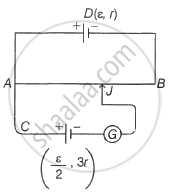
What is the effect of decreasing the current through the potentiometer on the null point?
A particle carrying 8 electron charges starts from rest and is accelerated through a potential difference of 9000 V. Calculate the KE acquired by it in keV.
State dimension of potential gradient.
In a potentiometer, a cell is balanced against 110 cm when the circuit is open. A cell is balanced at 100 cm when short-circuited through a resistance of 10 Ω. Find the internal resistance of the cell.
